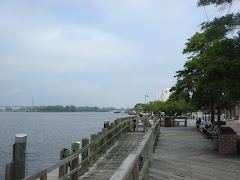With limited ocean ports and poor river navigation, North Carolina Virginia or South Carolina
Collins (Somerset ) Canal
A canal completed in 1788 connectingLake Phelps with the Scuppernong River Cresswell , NC
Dismal Swamp Canal Virginia and North Carolina leaders reached an agreement to build the Dismal Swamp Canal to connect the Pasquotank River and Albemarle Sounds to Deep Creek , VA , and the Norfolk
Collins (
A canal completed in 1788 connecting
Work resumed on the canal digging and the completed canal was open in 1805 to flatboat and barge traffic. The canal would always be affected by dry seasons and droughts. In 1814, a 20-ton, decked vessel passed through the canal, marking the first large boat to make the transit.
In 1827 - 1829, improvements were made in the canal to allow larger vessels with deeper drafts. In 1892, the Lake Drummond Canal & Water Company takes over the ownership and operation of the canal. The federal government purchased the canal in 1929.
Running basically north and south, this is the oldest man-made canal in continuous operation in the United States
Benjamin Jones of Camden Co. (NC) was the only North Carolinian on the first board of directors of the Dismal Swamp Canal Company, since most of the financial support for the effort came from Virginia
Length: 22 miles; Width (after 1829): 40 feet; Depth: originally 4 feet, later increased to 6.5 feet.
Cross Canal
This canal was opened in 1822. Ford B. Sawyer and Samuel Proctor were the initial proprietors of the Cross Canal in 1816 acquiring land to connect theDismal Swamp Canal
Length: 11 miles.
Roanoke Navigation Company & the Weldon (Roanoke
Length: 22 miles; Width (after 1829): 40 feet; Depth: originally 4 feet, later increased to 6.5 feet.
Cross Canal
This canal was opened in 1822. Ford B. Sawyer and Samuel Proctor were the initial proprietors of the Cross Canal in 1816 acquiring land to connect the
Length: 11 miles.
Roanoke Navigation Company & the Weldon (
The Roanoke Navigation Company was chartered in 1812 and began construction in 1817 to build the Roanoke (sometimes referred to as the Weldon) canal around a nine-mile, 85-foot drop at Great Falls on the Roanoke River . The work was completed in 1823. This canal opened boat traffic from the valleys of the Dan and Staunton to the North Carolina
Tolls collected from boats traveling the canal were $1,825.00 in 1830 and $12,190.22 in 1840. Railroad connections at and near Weldon, NC, in 1840 began a shift in freight transportation. The canal was abandoned around 1850.
Length: 12 miles in length.
Clubfoot & Harlowe (Harlow's)Creek Canal
Length: 12 miles in length.
Clubfoot & Harlowe (Harlow's)
Discussed prior to the Revolution, the canal never got underway in the 18th Century. Construction and planning got underway in 1795. In 1815, the North Carolina legislature authorized the formation of the Clubfoot and Harlow 's Creek Canal Company. A turf lock was completed in 1821, but failed. A more structurally sound lock was finished toward the end of the 1820s. The canal was in full operation by 1827. This canal linked Beaufort , NC
In 1880 it was re-opened as the New Berne and Beaufort Canal. The government acquired the canal in 1891.
Note: In 1911, a new canal was created two miles east of this waterway —Adams Creek-Cross Creek Canal
Length: 5-6 miles. Depth: 4 feet.
Bean Shoals Canal
Designed to bypass some falls in the upperYadkin River
Albemarle & Chesapeake Canal
The first canal company for this route was initially authorized in 1772. In 1809, another legislative bill created the Great Coastwise Canal & River Navigation Company to build the waterway. More private companies would be authorized and supercede this company over the decades.
Note: In 1911, a new canal was created two miles east of this waterway —
Length: 5-6 miles. Depth: 4 feet.
Designed to bypass some falls in the upper
The first canal company for this route was initially authorized in 1772. In 1809, another legislative bill created the Great Coastwise Canal & River Navigation Company to build the waterway. More private companies would be authorized and supercede this company over the decades.
Canal construction finally began in 1855. Opened in 1859, this canal provided access to larger ships than the Dismal Swamp Canal Norfolk area (through the south branch of the Elizabeth River ) to New Bern and Washington , NC
Length: 10 miles. Depth: originally 6 feet, later increased to 8-foot draft.
In addition to canals, there were numerous companies incorporated to deal in other ways with makingNorth Carolina Lockville Canal
Length: 10 miles. Depth: originally 6 feet, later increased to 8-foot draft.
In addition to canals, there were numerous companies incorporated to deal in other ways with making
Other efforts to either build canals or improve rivers were the Neuse Navigation Company (1818 - 1825), Yadkin Navigation Company (see Bean Shoals Canal, above), the Tar River Navigation Company, the Catawba Navigation Company (1827 - ; president Isaac Thomas Avery) and the New River Navigation Company. Very little came out of these efforts as state financial support was minimal ($185,000 in stock for all of these companies) compared to the amount that might actually be required.





No comments:
Post a Comment
Note: Only a member of this blog may post a comment.